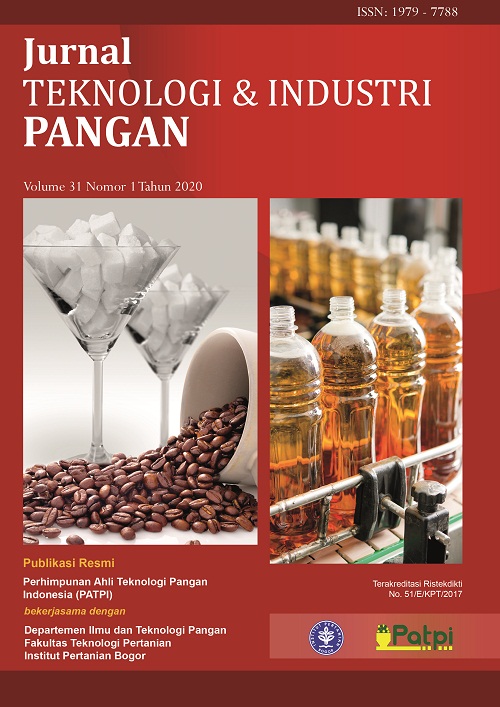PROFIL SENSORI DESKRIPTIF PRODUK PEMANIS TUNGGAL DAN CAMPURAN
Abstract
Sweetener as a food additive which gives sweet taste has a different profile from sucrose. Intensity profile and attribute sensation become very useful in developing mixed sweeteners from single sweeteners to create commercial sweeteners having a sucrose-like profile. However, there is only few data of attribute intensity and descriptive profiles of single sweeteners. The aim of this research was to analyze the des-criptive profile of single and mixed sweeteners using quantitative descriptive analysis (QDA), time intensity (TI), and temporal dominance of sensations (TDS) methods. The results of QDA descriptive profile showed that samples of a single sweetener T3 as well as mixed sweetener containing C2 and C5 had the same characteristics as sucrose. The results of TI descriptive profiles showed that the time intensity curves of sweet attribute of a sample of two mixed sweeteners C1 and C2, and a single sweetener T3 were similar to that of sucrose. The results of the descriptive profile using TDS methods generally showed that the do-minant attributes of all samples were sweet, sweet aftertaste, and licorice. Bitter and bitter aftertaste attri-butes were found in single sweetener T7, while mixed sweetener C1 had best sensory characteristics than the others.
References
Albert A, Salvador A, Schlich P, Fiszman S. 2012. Comparison between temporal dominance of sensations (TDS) and key-attribute sensory profiling for evaluating solid food with contrast-ing textural layers: Fish sticks. Food Qual Prefer 24: 111-118. DOI: 10.1016/j.foodqual. 2011.10.003.
[ASTM] American Society of Testing and Materials. 2011. ASTM E679-04: Standard practice for de-termination of odor and taste thresholds by a forced choice ascending concentration series method of limit. West Conshohocken: ASTM International. DOI: 10.1520/E0679-04RII.
Bruzzone F, Ares G, Gimenez A. 2013. Temporal aspects of yoghurt texture perception. Int Dairy J 29: 124-134. DOI: 10.1016/j.idairyj.2012.10. 012.
Carocho M, Morales P, Ferreira ICFR. 2017. Sweetener as food additives in the XXI century: A review of what is known, and what is to come. Food Chem Toxicol 107: 302-317. DOI: 10.101 6/j.fct.2017.06.046.
Cadena RS, Cruz AG, Netto RR, Castro WF, Faria JAF, Bolini HMA. 2013. Sensory profile and physicochemical characteristics of mango nec-tar sweetened with high intensity sweeteners throughout storage time. Food Res Int 54: 1670-1679. DOI: 10.1016/j.foodres.2013.10.0 12.
Chattopadhyay S, Raychaudhuri U, Chakrabotty R. 2014. Artificial sweeteners. J Food Sci Technol 51: 611-621. DOI: 10.1007/s13197-011-0571-1.
de Souza VR, Freire TVM, Saraiva CG, Carneiro JDS. 2013. Salt equivalence and temporal do-minance of sensations of different sodium chlo-ride substitute in butter. J Dairy Res 80: 319-325. DOI: 10.1017/S0022029913000204.
Di Monaco R, Miele NA, Volpe S, Picone D, Cavella S. 2014. Temporal sweetness profile of MNEI and comparison with comercial sweeteners. J Sens Stud 29: 385-394. DOI: 10.1111/joss.121 19.
Dinnella C, Masi M, Naes T, Monteleone E. 2013. A new approach in TDS data analysis: a case stu-dy on sweetened coffee. Food Qual Prefer 30: 33-46. DOI: 10.1016/j.foodqual.2013.04.006.
Edwards CH, Rossi M, Corpe CP, Butterworth PJ, Ellis PR. 2016. Commentary: The role of sugars and sweeteners in food, diet and health: Alter-native for the future. Trends Food Sci Technol 56: 158- 166. DOI: 10.1016/j.tifs.2016.07.008.
Klug C, Lipinki GW. 2012. AcesulfameK. Sweete-ners and Sugar Alternatives in Food Technolo-gy. O’Donnell K, Kearsley M.W. (Eds). Willey Blackwell, USA.
Meilgard MC, Civile GV, Carr BT. 2016. Sensory Evaluation Techniques (5th ed). 201-2016. CRC Press Taylor & Francis Group, Boca Raton London.
Morais EC, Pinheiro ACM, Nunes CA, Bolini HMA. 2014. Multiple time-intensity analysis and tem-poral dominance of sensations of chocolate dairy dessert using prebiotic and different high-intensity sweeteners. J Sens Stud 29: 1-12. DOI: 10.1111/joss.12115.
Nabors L, Hedrick T. 2012. Sugar reduction with po-lyols. Food Technol Magazine 9: 22-29.
Ng M, Lawlor JB, Chandra S, Chaya C, Hewson L, Hort J. 2012. Using quantitative descriptive analysis and temporal dominance of sensations analysis as complementary methods for pro-filing commercial blackcurrant squashes. Food Qual Prefer 25: 121-134. DOI: 10.1016/j.food qual.2012.02.004.
O’Donnell K. 2012. Sweeteners and Sugar Alterna-tives in Food Technology Second Edition. p: 215-220. John Wiley and Sons, Ltd, The Autrium (UK).
Palazzo AB, Carvalho MAR, Efraim P, Bolini HMA. 2011. The determination of isosweetness con-centrations of sucralose, rebaudioside and neo-tame as sucrose substitutes in new diet choco-late formulations using the time-intensity ana-lysis. J Sens Stud 26: 291-297. DOI: 10.1111/j. 1745-459X.2011.00344.x.
Patil S, Ravi R, Saraswati G, Prakash M. 2012. De-velopment of low calorie snack food based on intense sweeteners. J Food Sci Technol 51: 4096-4101. DOI: 0.1007/s13197-012-0911-9.
Pineau N, Bouille AG, Lepage M, Lenfant F, Schlich P, Martin N, Rytz A. 2012. Temporal domi-nance of sensations: What is a good attribute list?. Food Qual Prefer 26: 159-165. DOI: 10. 1016/j.foodqual.2012.04.004.
Sediva A, Panovska Z, Pokorny J. 2006. Sensory profiles of sweeteners in aqueous solutions. Czech J Food Sci 24: 283-287. DOI: 10.17221/ 3326-CJFS.
Zorn S, Alcaire F, Vidal L, Gimenez A, Ares G. 2014. Application of multiple-sip temporal dominance sensations to the evaluation of sweeteners. Food Qual Prefer 36: 135-143. DOI: 10.1016/j. foodqual.2014.04.003.

